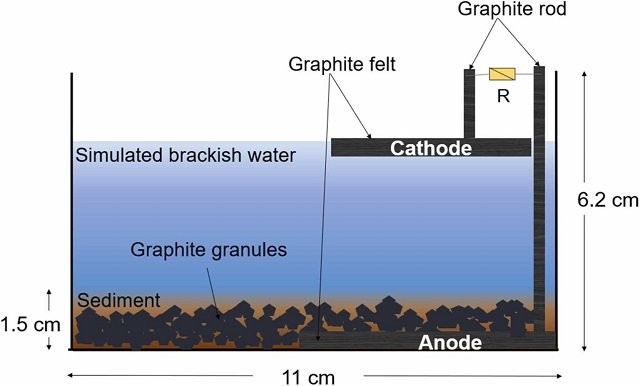
The aquaculture industry can suffer substantial losses due to vibriosis, a disease caused by the Vibrio bacteria commonly found in aquaculture systems.
To reduce the presence of vibrios in aquaculture ponds, various measures have been proposed, including the use of chemical disinfectants, antibiotics, and microbial products. However, each of these measures has its advantages and disadvantages.
Conventional measures, often relying on antibiotics, have proven to be disadvantageous and require the exploration of innovative solutions for long-term success.
In this pursuit, researchers from Vietnam National University have delved into the potential of Sediment Bioelectrochemical Systems (SBES) as an innovative method to control Vibrio harveyi and V. parahaemolyticus bacteria, consequently revolutionizing aquaculture practices.
Bioelectrochemical Sediment Systems (SBES)
Researchers have identified Bioelectrochemical Sediment Systems (SBES) as a novel solution based on antimicrobial activities.
According to research reports, in SBES, biocatalysts (specifically bacteria) catalyze electrochemical reactions through their interactions with electrodes.
Pioneering studies on the antimicrobial activities of SBES demonstrated that bacteria can be inhibited at the cathode of an SBES due to increases in pH or oxidative residues.
The Study
The study involved installing SBES in lab-scale plastic tanks containing artificial brackish water, while control tanks without SBES served as a baseline.
Once the SBES consistently generated electricity, tests were conducted using strains of Vibrio harveyi (Vh) and Vibrio parahaemolyticus (Vp). Various exposure methods were employed, and plate enumeration was utilized to evaluate the inhibitory effects of SBES-treated water on Vibrio strains.
Key Results
The results were remarkable, indicating that almost 100% of Vh and Vp cells could not grow after just 5 minutes in contact with SBES water. In contrast, more than 80% of these cells could still grow after 1 to 2 hours in contact with water from the control tanks.
“In this study, we demonstrated the inhibitory effects of SBES on two species of pathogenic Vibrio for the first time,” report the researchers, highlighting that the effects could include Vibrio bacterial mortality, as evidenced by the reduction in CFU count.
Parallel tests revealed that SBES water was also toxic to Escherichia coli but only slightly inhibited the growth of beneficial bacteria such as Bacillus pumilus and Lactobacillus plantarum.
Mechanism of Action
Further investigations explored the potential mechanisms behind these inhibitory effects. Tests ruled out suspected proteinaceous components, metal contents, or peroxides in SBES water as causative factors.
However, applying a redox potential of 20 mV (vs. Ag/AgCl) onto a graphite rod immersed in a Vh cell suspension led to a 90% growth inhibition of the cells. Similar experiments with titanium, known to be non-toxic to bacteria, confirmed the vibrio-inhibiting effect of the applied redox potential.
Implications for Aquaculture
The findings of the study have promising implications for the aquaculture industry. The integration of Sediment Bioelectrochemical Systems (SBES) into aquaculture ponds emerges as a novel technological option for in situ vibriosis control.
Significantly, this approach minimizes reliance on antibiotics and other chemicals, aligning with the global push for more sustainable aquaculture practices.
According to the researchers, “With its vibrio-inhibiting effect, SBES offers a new and highly promising technology in aquaculture for in situ control of pathogenic vibrios. Moreover, the relatively selective effect of SBES on vibrios, due to its mild impact on other bacteria, especially gram-positive bacilli and lactobacilli, is indeed a significant advantage (compared to other technologies) because these bacilli and lactobacilli are often used as probiotics for aquatic plants, animals, and for pond water bioremediation.”
They also indicate that the environment created by SBES may have more positive than negative effects on aquaculture systems and may not adversely affect the cultured animals. The researchers report preliminary tests on white shrimp (Litopenaeus vannamei), highlighting no harmful effects on the shrimp.
Conclusion
Bioelectrochemical sediment systems present a revolutionary breakthrough in combating vibriosis in aquaculture. The study’s evidence of SBES inhibitory effects on Vibrio strains, coupled with mild effects on beneficial bacteria, underscores its potential as a sustainable and effective alternative to conventional methods.
As the aquaculture industry seeks ecological solutions, the integration of SBES offers a promising pathway toward a more resilient and sustainable future.
“SBES offers a novel and promising technological option for in situ control of Vibrio pathogens in aquaculture, replacing antibiotics and reducing the water treatment burden, thus ensuring greater sustainability in the future,” concluded the researchers.
The study has been funded by the Vietnam National Foundation for Science and Technology Development (NAFOSTED).
Contact
Hai The Pham
GREENLAB, Center for Life Science Research (CELIFE)
Faculty of Biology, VNU University of Science
Vietnam National University
334 Nguyen Trai, Thanh Xuan, Hanoi, Viet Nam.
Email: phamthehai@vnu.edu.vn
Reference (open access)
Phuong Ha Vu, Nhung Hong Tran, Thuy Thu Thi Nguyen, Hanh My Tran, Ha Viet Thi Bui, Huy Quang Nguyen, Thao Kim Nu Nguyen, Hai The Pham. 2023. Sediment bioelectrochemical system with potential application against vibriosis in aquaculture, Aquaculture Reports, Volume 33, 2023, 101826, ISSN 2352-5134,
https://doi.org/10.1016/j.aqrep.2023.101826.
Editor at the digital magazine AquaHoy. He holds a degree in Aquaculture Biology from the National University of Santa (UNS) and a Master’s degree in Science and Innovation Management from the Polytechnic University of Valencia, with postgraduate diplomas in Business Innovation and Innovation Management. He possesses extensive experience in the aquaculture and fisheries sector, having led the Fisheries Innovation Unit of the National Program for Innovation in Fisheries and Aquaculture (PNIPA). He has served as a senior consultant in technology watch, an innovation project formulator and advisor, and a lecturer at UNS. He is a member of the Peruvian College of Biologists and was recognized by the World Aquaculture Society (WAS) in 2016 for his contribution to aquaculture.
